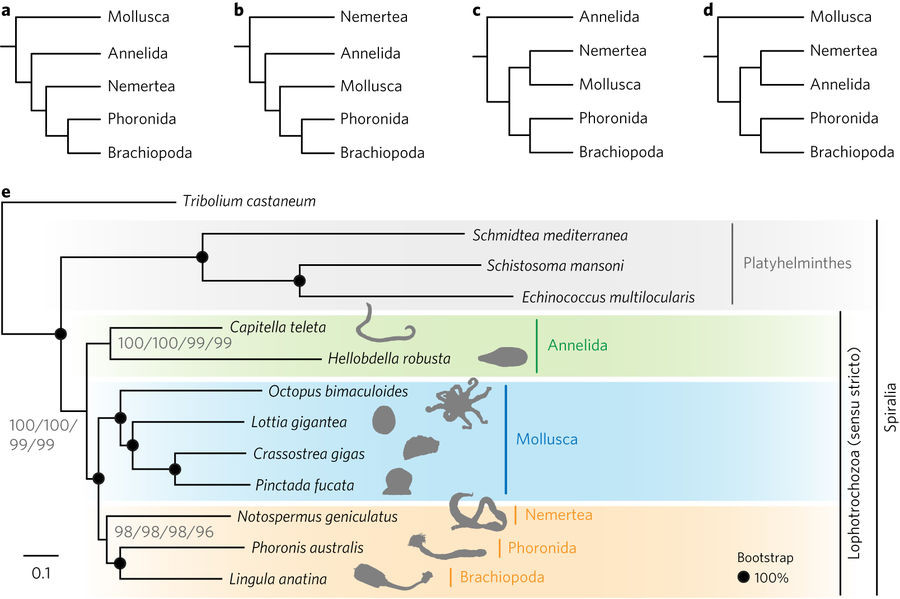紐形動物と箒虫動物のゲノムから冠輪動物の進化と左右相称動物の頭部の起源が明らかになった OPEN
Nemertean and phoronid genomes reveal lophotrochozoan evolution and the origin of bilaterian heads
2017年12月4日 Nature Ecology & Evolution 2 : 141 doi: 10.1038/s41559-017-0389-y

紐形動物(ヒモムシ類)と箒虫動物(ホウキムシ類)は、互いに近縁な冠輪動物(ヒル類や腹足類などの無脊椎動物を含む動物群)である。冠輪動物は、左右相称動物の進化を解明する上で極めて重要な上門である。しかし、紐形動物と箒虫動物に関する分子データと形態データには矛盾点があり、両者の起源はよく分かっていなかった。今回我々は、紐形動物のミサキヒモムシ(Notospermus geniculatus)と箒虫動物のホウキムシ(Phoronis australis)の概要ゲノムを明らかにし、それと共に、成体の各部位のトランスクリプトームも示す。得られたゲノム情報に基づく系統解析から、紐形動物は、箒虫動物と腕足動物を含む動物群の姉妹群として位置付けられた。また、冠輪動物は新口動物と多くの遺伝子ファミリーを共有していることが明らかになり、この2つの動物群は、脱皮動物上門(ハエ類や線虫類など)および扁形動物上門(扁形動物やワムシ類など)にはない左右相称動物の中核的な遺伝子レパートリーを保持していることが示唆された。比較トランスクリプトミクスからは、箒虫動物と腕足動物の触手冠が、形態だけでなく分子レベルでも似ていることが明らかになった。頭部の構造が似ていないにもかかわらず、触手冠では脊椎動物の頭部や神経のマーカー遺伝子が発現している。この知見から、左右相称動物の頭部パターン形成の起源は共通しているが、系統ごとに異なる頭部が独立に進化したことが示唆される。さらに、自然免疫や毒素関連の遺伝子には系統特異的な拡張が認められた。総合すると、今回の研究結果は、保存された特徴と系統特異的な特徴によって進化が方向付けられるという冠輪動物の二面性を明らかにしている。
Corresponding Authors
Nemerteans (ribbon worms) and phoronids (horseshoe worms) are closely related lophotrochozoans—a group of animals including leeches, snails and other invertebrates. Lophotrochozoans represent a superphylum that is crucial to our understanding of bilaterian evolution. However, given the inconsistency of molecular and morphological data for these groups, their origins have been unclear. Here, we present draft genomes of the nemertean Notospermus geniculatus and the phoronid Phoronis australis, together with transcriptomes along the adult bodies. Our genome-based phylogenetic analyses place Nemertea sister to the group containing Phoronida and Brachiopoda. We show that lophotrochozoans share many gene families with deuterostomes, suggesting that these two groups retain a core bilaterian gene repertoire that ecdysozoans (for example, flies and nematodes) and platyzoans (for example, flatworms and rotifers) do not. Comparative transcriptomics demonstrates that lophophores of phoronids and brachiopods are similar not only morphologically, but also at the molecular level. Despite dissimilar head structures, lophophores express vertebrate head and neuronal marker genes. This finding suggests a common origin of bilaterian head patterning, although different heads evolved independently in each lineage. Furthermore, we observe lineage-specific expansions of innate immunity and toxin-related genes. Together, our study reveals a dual nature of lophotrochozoans, where conserved and lineage-specific features shape their evolution.

